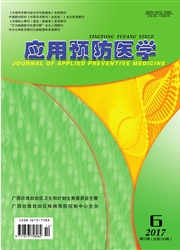

 中文摘要:
中文摘要:
目的探讨人类白细胞相关抗原复合体的DRB1*07/09/11等位基因对广西肝癌高发区肝癌家族聚集性的影响。方法以配对方法选取广西肝癌高发区的肝癌高发家族成员、肝癌单发家族成员及无癌家族成员各153例作为研究对象,应用聚合酶链反应/序列特异性引物(PCR-SSP)方法检测HLA-DRB1*07/09/11等位基因,统计分析各等位基因与原发性肝癌家庭聚集性的相关性。结果(1)HLA-DRB1*07/09等位基因在肝癌高发家族成员组、肝癌单发家族成员组和无癌家族成员组的基因频率分别为0.70%和2.00%、2.60%和19.oo%、23.50%和16.30%(P〉0.05);HLA-DRB1*11为2.60%、13.70%和-11:10%(P〈0.01);(2)HLA—DRB1*07/09/11等位基因在乙型肝炎病毒感染成员组(HBsAg阳性组)及非乙肝病毒感染成员组(HBsAg阴性组)中的基因频率分别为:0%、2.60%;19.00%、19.90%和9.50%、9.00%(P值均〉0.05)。结论(1)HLA—DRB1*11等位基因可能是广西肝癌高发区原发性肝癌发生的拮抗基因,其缺失可能是导致广西肝癌高发区肝癌家族聚集性原因之一。(2)HLA—DRB1*07、09、11等位基因与广西肝癌高发区乙肝病毒感染的易感性似无明显关联。
 英文摘要:
英文摘要:
Objective To study the effect of HLA-DRB1*07/09/11 alleles on familial aggregation of hepatocellular carcinoma(HCC) in high hepatocellular carcinoma incidence area of Guangxi. Methods 153 family members from those families which have had two or more than two patients with hepatocellular carcinoma ( FHHC group ) , 153 from those families which have had only one patient with hepatocellular careinoma(FOHC group) and 153 from those families which have had none carcinoma patients(FNC group) were selected and matched as study object in the high hepatocellular carcinoma incidence areas of Guangxi. Polymerase chain reaction using sequence specific primer (PC R-SSP) was employed to tested HLA-DRB 1*07, HLA-DRB 1*09, HLA-DRB 1 *11 alleles; the correlation bewteen HLA-DRB 1*07/09/11 alleles and familial aggregation of HCC in the high hepatocellular carcinoma incidence areas of Guangxi was analysed by statistical methods. Results (1) The gene frequency of allele HLA-DRB1*07 in the FHHC group,FOHC group and FNC group was 0.7%,2.0% and 2.6% (P〉0.05) respectively; HLA-DR B 1"09 was 19.00%, 23.50% and 16.30% (P〉0.05); HLA-DRB 1" 11 was 2.60%, 13.70% and 11.10% ( P〈0.01 ) .(2) The gene frequency of HLA-DRB1*07,09 and 11 alleles in HBsAg postive 'group and HBsAg negative group Was respectively: HLA-DRB1* 07 was 0% and 2.60% (X^2=1.70, P〉0.05 ) ", HLA-DRB1*09 was 19.0% and 19.9% ( X^2=0.04, P〉0.05 ) HLA-DRB1*11 was 9.50% and 9.00% ( Z2=0.04, P〉0.05 ) . Conclusions (1)HLA-DRB1*11 seems to be the antagonist genes of hepatocellular carcinoma in high HCC incidence areas of Guangxi, and the gene deletion may be the cause of leading to the familial aggregation of hepatocellular carcinoma in high HCC incidence areas of Guangxi. (2) There may be not significant correlation bewteen HLA-DRB 1*07, 09,and 11 alleles and the susceptibility of HBV infection in high HCC incidence area of Guangxi.
 同期刊论文项目
同期刊论文项目
 同项目期刊论文
同项目期刊论文
 期刊信息
期刊信息
